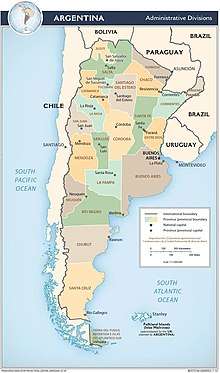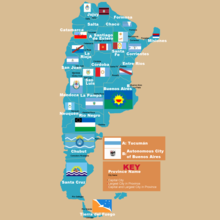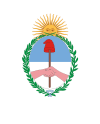Provinces of Argentina
Argentina is subdivided into twenty-three provinces (Spanish: provincias, singular provincia) and one autonomous city (ciudad autónoma), Buenos Aires, which is the federal capital of the nation (Spanish: Capital Federal) as decided by Congress.[1] The provinces and the capital have their own constitutions, but exist under a federal system.
| Provinces of Argentina | |||||||
|---|---|---|---|---|---|---|---|
| Category | Federated state | ||||||
| Location | Argentine Republic | ||||||
| Number | 23 Provinces 1 Autonomous city | ||||||
| Government | Provincial government | ||||||
| Subdivisions | |||||||
| |||||||
 |
|---|
| This article is part of a series on the politics and government of Argentina |
|
|
Legislative
|
|
|
|
|
|
History
During the War of Independence the main cities and their surrounding countrysides became provinces though the intervention of their cabildos. The Anarchy of the Year XX completed this process, shaping the original thirteen provinces. Jujuy seceded from Salta in 1834, and the thirteen provinces became fourteen. After seceding for a decade, Buenos Aires Province accepted the 1853 Constitution of Argentina in 1861, and its capital city was made a federal territory in 1880.[2]
A law from 1862 designated as national territories those under federal control but outside the frontiers of the provinces. In 1884 they served as bases for the establishment of the governorates of Misiones, Formosa, Chaco, La Pampa, Neuquén, Río Negro, Chubut, Santa Cruz and Tierra del Fuego.[3] The agreement about a frontier dispute with Chile in 1900 created the National Territory of Los Andes; its lands were incorporated into Jujuy, Salta and Catamarca in 1943.[2] La Pampa and Chaco became provinces in 1951. Misiones did so in 1953, and Formosa, Neuquén, Río Negro, Chubut and Santa Cruz, in 1955. The last national territory, Tierra del Fuego, became the Tierra del Fuego, Antártida e Islas del Atlántico Sur Province in 1990.[2]
Political organization
Argentina is a federation of twenty-three provinces and one autonomous city, Buenos Aires. Provinces are divided for administration purposes into departments and municipalities, except for Buenos Aires Province, which is divided into partidos and localidades. Buenos Aires City itself is divided into communes (comuna) and non-official neighbourhoods (barrios).


Provinces hold all the power that they chose not to delegate to the federal government;[4] they must be representative commonwealths and must not contradict the Constitution.[5] Beyond this, they are fully autonomous: they enact their own constitutions,[6] freely organize their local governments,[7] and own and manage their natural and financial resources.[8] Thus, each province has its own set of provincial laws and justice system, a supreme court, a governor, an autonomous police force, and a congress; in eight provinces, this legislature is bicameral, comprising an upper chamber (the Senate) and a lower chamber (the House of Deputies), while in the remaining fifteen provinces and in Buenos Aires City, it is unicameral.[9][upper-alpha 1]
In case of sedition, insurrection, territorial invasion, or any other emergent against the laws of the Nation on any province or the federal capital, the Congress has the authority to declare a federal intervention on the compromised district,[11] even in the absence of a formal request by the affected part.[12] When Congress is in recess and thus unable to decide, the President is entitled to decree such intervention, but this executive order is subject to Congressional override upon the Houses' immediate reassembly.[13] Once the intervention is declared the compromised district's government is immediately dissolved—in whole or in part depending on Congressional decision—and the President appoints a representative or intervenor, who will serve for a short time until the emergency is solved. Since 1983 four provinces were intervened, namely Catamarca, Corrientes (twice), Santiago del Estero (twice), and Tucumán.[14]
During the 20th century, some provinces have had governments that are traditionally controlled by a single family (i.e. the Saadi family in Catamarca, or the Sapag family in Neuquén); in one case, it is still the same situation from 2009: the Province of San Luis was ruled almost without a break by the Rodríguez Saá family since December 1983.[15]
Article 61 of the Constitution of the city of Buenos Aires states that "Suffrage is free, equal, secret, universal, compulsory and not accumulative. The foreign residents enjoy this right, with the correlative obligations, on equal terms with Argentine citizens registered in this district, in the terms established by the law."[16]
List of provinces and the autonomous city
| Flag | Province | Capital | HASC subdivision code | Population (2010)[18] | Pop. Est. (2018)[19] | Area |
|---|---|---|---|---|---|---|
| Ciudad de Buenos Aires | — | DF | 2,890,151 | 3,068,043 | 203 km2 (78 sq mi) | |
| Buenos Aires | La Plata | BA | 15,625,084 | 17,196,396 | 307,571 km2 (118,754 sq mi) | |
| Catamarca | San Fernando del Valle de Catamarca | CT | 367,828 | 408,152 | 102,602 km2 (39,615 sq mi) | |
| Chaco | Resistencia | CC | 1,055,259 | 1,180,477 | 99,633 km2 (38,469 sq mi) | |
| Chubut | Rawson | CH | 509,108 | 598,380 | 224,686 km2 (86,752 sq mi) | |
| Córdoba | Córdoba | CB | 3,308,876 | 3,683,937 | 165,321 km2 (63,831 sq mi) | |
| Corrientes | Corrientes | CN | 992,595 | 1,101,084 | 88,199 km2 (34,054 sq mi) | |
| Entre Ríos | Paraná | ER | 1,235,994 | 1,360,443 | 78,781 km2 (30,418 sq mi) | |
| Formosa | Formosa | FM | 530,162 | 595,129 | 72,066 km2 (27,825 sq mi) | |
 |
Jujuy | San Salvador de Jujuy | JY | 673,307 | 753,891 | 53,219 km2 (20,548 sq mi) |
| La Pampa | Santa Rosa | LP | 318,951 | 352,378 | 143,440 km2 (55,380 sq mi) | |
| La Rioja | La Rioja | LR | 333,642 | 383,220 | 89,680 km2 (34,630 sq mi) | |
 |
Mendoza | Mendoza | MZ | 1,738,929 | 1,949,293 | 148,827 km2 (57,462 sq mi) |
| Misiones | Posadas | MN | 1,101,593 | 1,233,177 | 29,801 km2 (11,506 sq mi) | |
| Neuquén | Neuquén | NQ | 551,266 | 646,784 | 94,078 km2 (36,324 sq mi) | |
| Río Negro | Viedma | RN | 638,645 | 728,403 | 203,013 km2 (78,384 sq mi) | |
| Salta | Salta | SA | 1,214,441 | 1,388,532 | 155,488 km2 (60,034 sq mi) | |
| San Juan | San Juan | SJ | 681,055 | 764,464 | 89,651 km2 (34,614 sq mi) | |
| San Luis | San Luis | SL | 432,310 | 495,629 | 76,748 km2 (29,633 sq mi) | |
| Santa Cruz | Río Gallegos | SC | 273,964 | 347,593 | 243,943 km2 (94,187 sq mi) | |
| Santa Fe | Santa Fe | SF | 3,194,537 | 3,481,514 | 133,007 km2 (51,354 sq mi) | |
| Santiago del Estero | Santiago del Estero | SE | 874,006 | 958,251 | 136,351 km2 (52,645 sq mi) | |
| Tierra del Fuego | Ushuaia | TF | 127,205a | 164,944 | 21,263 km2 (8,210 sq mi)a | |
| Tucumán | San Miguel de Tucumán | TM | 1,148,188 | 1,654,388 | 22,524 km2 (8,697 sq mi) |
See also
- Demographics of Argentina
- ISO 3166-2:AR, the ISO codes for the provinces of Argentina.
- List of Argentine Provinces by Human Development Index
- List of Argentine provinces by gross domestic product
- Comparison between Argentine provinces and countries by GDP (PPP) per capita
Notes
- The City of Buenos Aires is an autonomous city, but its local organization has similarities with the provinces: it has its own constitution, an elected mayor, a congress, and representatives to the Senate and Deputy chambers.[10]
References
- Constitution of Argentina, art. 3.
- Rey Balmaceda 1995, p. 19.
- Rock 1987, p. 155.
- Constitution of Argentina, art. 121.
- Constitution of Argentina, arts. 5, 6.
- Constitution of Argentina, art. 123.
- Constitution of Argentina, art. 122.
- Constitution of Argentina, arts. 124, 125.
- "Legislaturas de la Ciudad de Buenos Aires y provinciales – República Argentina" (in Spanish). Universidad del Salvador. Archived from the original on 2013-05-15. Retrieved 2009-09-19.
- Constitution of Argentina, art. 129.
- Constitution of Argentina, art. 6.
- Constitution of Argentina, art. 75 inc. 31.
- Constitution of Argentina, art. 99 inc. 20.
- "Intervenciones en la historia". La Nación (in Spanish). 11 April 2004. Archived from the original on 11 October 2012.
- "Archivo Histórico – Gobernadores provinciales de la República Argentina 1983–2007" (in Spanish). Ministerio del Interior – Presidencia de la Nación. Archived from the original on 8 June 2009. Retrieved 8 June 2009.
- "Constitución de la Ciudad Autónoma de Buenos Aires" (in Spanish). Ciudad Autónoma de Buenos Aires. October 1, 1996. Archived from the original on 2007-11-22. Retrieved 2007-12-13.
- Gwillim Law (30 May 2015). "Provinces of Argentina". Statoids. Retrieved 28 September 2015.
- "Cuadro 8. Población total, superficie y densidal según provincia. Total del país" (PDF) (in Spanish). indec. October 2012. p. 66. Retrieved 8 May 2020.
- "Cuadros 1.2-1.25: Población estimada al 1o de julio por sexo, según año calendario" (PDF). Proyecciones provinciales de poblácion por sexo y grupo de edad (in Spanish). Indec. December 2013. pp. 20–43. Retrieved 9 May 2020.
Bibliography
- Legal documents
- National Constituent Convention (22 August 1994), Constitution of the Argentine Nation, Santa Fe, archived from the original on 4 June 2011CS1 maint: uses authors parameter (link)
- Books
- Rey Balmaceda, Raúl (1995). Mi país, la Argentina (in Spanish). Buenos Aires: Arte Gráfico Editorial Argentino. ISBN 84-599-3442-X.CS1 maint: ref=harv (link)
- Rock, David (1987). Argentina, 1516-1987: From Spanish Colonization to the Falklands War. University of California Press. ISBN 978-0520061781.CS1 maint: ref=harv (link)
External links
| Wikimedia Commons has media related to Provinces of Argentina. |
- Provinces of Argentina at statoids.com
- Argentine Provinces since 1973 at World Statesmen